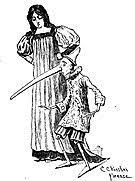It’s surely no accident that some wise people have chosen the Midsummer season for International Fairy Day. The mythical creatures are associated with this time of year for literary reasons yes, but before that, for explanations surely more related to folk culture and the seasonal appearance of butterflies, dragonflies, fireflies, bats, and so forth. Things flit through the air in the summer, and they sure look magical, even if the natural explanations are earthbound. As a lover of folk culture, the 19th century, Victoriana, etc the topic aroused my curiosity (in much the same vein as my recent Mermaid post) and so here is a sort of simplified fairy folklore timeline.
The word was originally “fay” or (in French) “fée”. As in Morgan Le Fay, the witch in the Arthurian legend, one of the first references to such a character. I imagine the vaudeville psychic Anna Eva Fay also had the name very much in mind when she was promoting her act. It is an evolving concept. Some versions in stories seem to possess a connection to the similar sounding Greek Fates. Fairy Godmothers seem to have similar powers to the Fates (e.g. in Sleeping Beauty). And in some artists renderings, fairies are depicted as having some faun-like features. Sometimes they seem to overlap in concept with Angels (Guardian or otherwise) or with Demons. And some have noted the similarity of the word to “Peri”, a Persian folkloric character. There are angel like characters in Zoroastrianism. Fairies are almost always winged and tiny. Sometimes they seem more like witches and wizards, and even have magic wands. On the whole the mythological origins seem more drawn from Celtic and Germanic origins. Sometimes they seem indistinguishable from household spirits like imps, brownies, sprites, hobgoblins, pixies, bogeys, elves, and so forth.
The word “faerie” originally referred to a dwelling for fays, just as an “aerie” is a nest for eagles. Somewhere down the line the word morphed in meaning, and those who lived in faeries, i,e, faerie-dwellers, became just faeries.
Puck, Robin Goodfellow or Hobgoblin — references to this fairy character date at least to the early 1500s, though he surely emerged sooner. The similarly named Robin Hood dates to at least a couple of centuries earlier.
Spenser’s The Faerie Queene (1590)
Shakespeare’s A Midsummer Night’s Dream (ca. 1590)
Madame d’Aulnoy coins the term “Fairy Tales” in Les Contes des Fées (1697)
Charles Perrault’s Fairy Tales (1697)
Grimm’s Fairy Tales (1812)
Hans Christian Andersen’s Fairy Tales (1835-37)
Gilbert and Sullivan’s Iolanthe, or The Peer and the Peri (1882)
Collodi’s Pinocchio introduces The Fairy with Turquoise Hair a.k.a. The Blue Fairy (1883)
Lang’s Fairy Books (1889-1913)
Yeats’ Fairy and Folk Tales of Ireland (1888-92)
Tschaikovsky introduces the Sugar Plum Fairy in The Nutcracker (1892)
The character is not in E.T.A. Hoffman’s original 1816 tale.
J.M. Barrie gives us Tinker Bell in Peter Pan (1904)
The character was depicted as only a point of light in the original stage production. Throughout the 19th and early 20th centuries there were countless first hand accounts of “actual” fairy sightings that sound not unlike contemporary ones in the ghost hunting community about “light orbs”. In both cases, I’m pretty sure there are some plausible natural explanations, short of hobgoblins.
Cottingley Fairies (1917-21)
In the best thing that ever happened in the history of humankind, two little girls in Cottingley, England, Elsie Wright and Frances Griffiths fooled a substantial portion of the grown-up world (including Sir Arthur Conan Doyle) with some faked fairy photographs. Doyle actually wrote a book (The Coming of the Fairies) in support of the girls, who had effected their stunt with nothing more than paper cut-outs. The incident was later fictionalized in the movie Fairy: A True Story (1997). Harvey Keitel plays Houdini!
There Are Fairies at the Bottom of My Garden (1917)
Rose Fyleman’s poem is published in Punch. Soon set to music by Liz Lehmann, the resulting song becomes one of the signature tunes in the repertoire of Beatrice Lillie. Fyleman would go on to write numerous fairy-related books for book grown-ups and children
The Blue Fairy (1940)
Pinocchio’s Blue Fairy becomes the first of countless Fairy characters popularized by Walt Disney, followed by Cinderella‘s Fairy Godmother (1950) and Peter Pan‘s Tinkerbell, which became a sort of secondary company mascot, after Mickey Mouse.
Radical Faeries (1970’s-present)
The inevitable Pride Month tie-in. I first learned about this amazing group when I was researching theatrical protest movements about 20 years ago (which I wrote about here). The Radical Faeries are a west-coast movement that mixes elements of the gays rights movement, environmentalism, drag, anarchists, and, like…the Ren Fest movement? There seem to be elements of the Ridiculous, and The Cockettes but it’s also a back to nature thing not unlike these green neo-pagan folks. They were founded by Harry Hay, whom we wrote about we wrote about in connection to his friendship with Will Geer. There many chapters throughout the U.S. and the U.K.
And now fairy culture has expanded beyond the gay community, to wit…
It undoubtedly won’t shock you to know that there is a contemporary fairy subculture, just as there is with vampires, mermaids, witches, and so forth, and there even classes you can take that acclimate you to the fairy lifestyle. It’s probably not for everybody. We all have our cultural cul de sacs. If I’m going to pick one to ridicule and scorn today, it won’t be this one. My list is usually topped by the pinheads who are into romancing guns. A little more belittling of THAT, please.





















You must be logged in to post a comment.